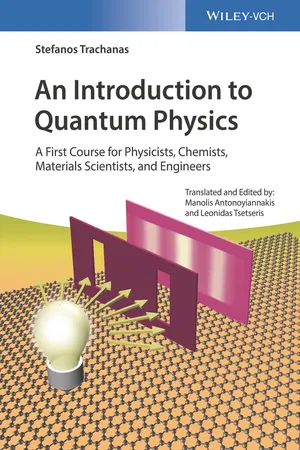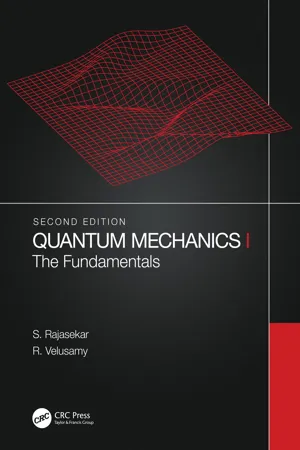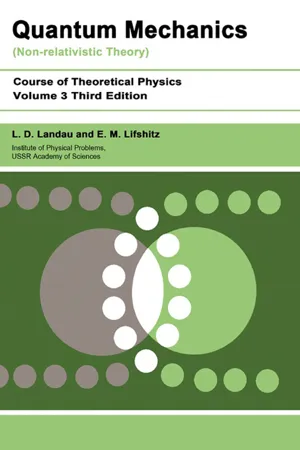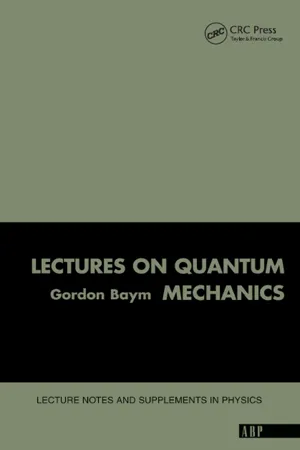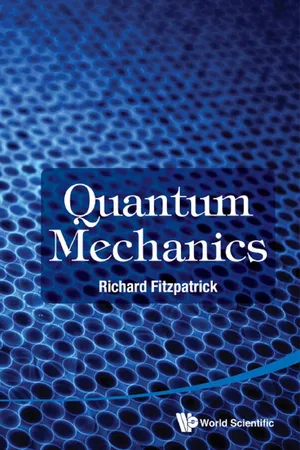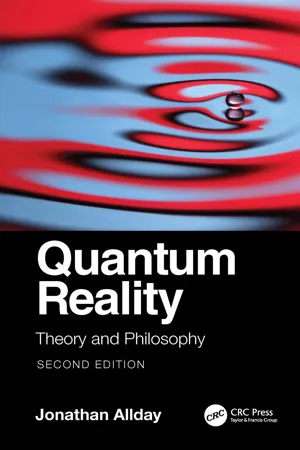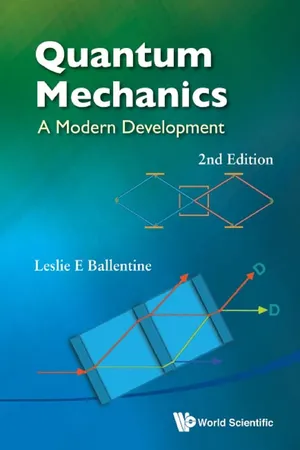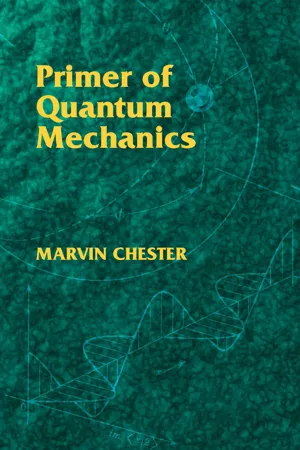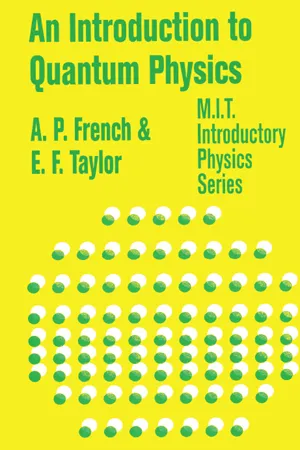Physics
Identical Particles in Quantum Mechanics
Identical particles in quantum mechanics are particles that cannot be distinguished from one another. This means that the wave function describing the system must be symmetric or antisymmetric under particle exchange. The Pauli exclusion principle states that no two identical fermions can occupy the same quantum state simultaneously.
Written by Perlego with AI-assistance
Related key terms
Related key terms
1 of 4
Related key terms
1 of 3
10 Key excerpts on "Identical Particles in Quantum Mechanics"
- eBook - ePub
An Introduction to Quantum Physics
A First Course for Physicists, Chemists, Materials Scientists, and Engineers
- Stefanos Trachanas, Manolis Antonoyiannakis, Leonidas Tsetseris(Authors)
- 2017(Publication Date)
- Wiley-VCH(Publisher)
Chapter 11 Identical Particles and the Pauli Principle11.1 Introduction
We will now discuss the second foundational premise—the first one was the uncertainty principle—of quantum theory: the Pauli principle. This will allow us to pursue, in the following chapters, our ultimate goal, which is to understand the structure of matter from first principles. To understand the structure of atoms—and how their basic properties are mapped in a periodic table—and proceed from there to construct the quantum theory of the chemical bond and extend it to crystalline solids. Let us begin.11.2 The Principle of Indistinguishability of Identical Particles in Quantum Mechanics
The concept of identical particles is surely the same in both classical and quantum mechanics. We call identical all those particles that share the exact same physical properties: mass, charge, spin, baryon or lepton number, and any other quantum number required for their complete identification. Put in a different way, all particles of the same species are identical: all electrons, all protons, all photons, and so on.But there is one fundamental difference between classical and quantum mechanics when it comes to distinguishing identical particles of a physical system. In classical mechanics, we can always tell one identical particle from another because of the uniqueness of their orbits that allows us to know at any moment which one is particle , which one is particle , and so on. In contrast, in quantum mechanics, it is impossible to distinguish between particles of the same physical system (e.g., electrons in an atom), since these are described by overlapping wavefunctions that allow the particles to be found at the same point in space, which renders their identification impossible. This fundamental difference between classical and quantum mechanics is demonstrated in Figure 11.1 - eBook - ePub
Quantum Mechanics I
The Fundamentals
- S. Rajasekar, R. Velusamy(Authors)
- 2022(Publication Date)
- CRC Press(Publisher)
18 Identical ParticlesDOI: 10.1201/9781003172178-1818.1 Introduction
Two particles are said to be identical when it is not possible to distinguish one particle from the other particle with their inherent physical properties such as mass, charge, spin, etc. Study of identical particles is important for two reasons:- Many-body systems contain usually identical particles.
- They give rise quantum mechanical phenomena that have no classical analogues.
In classical mechanics, we can able to know the trajectory of any particle given its initial position, momentum and the forces acting on it. When we consider a system with two or more identical particles, in principle, we can distinguish them at any time as each one of the particles follows a definite predictable path. This is because classical mechanics is a deterministic theory. For example, when two identical particles collide, we can determine the paths of these particles after collision as their paths are known before the collision. So, in classical mechanics, it is possible to distinguish two identical particles. Also, any particle can be observed without affecting its behaviour.In quantum mechanics the situation is different because the uncertainty principle does not allow us to know the initial positions and momenta of the particles with desired accuracy. The individual particle is described by a wave packet. Since the wave packet is not localized and spreading with time, it is impossible to distinguish two identical particles as their wave functions always overlap at any point in space. Unless the two particles are well separated with no overlap of their wave functions, quantum identical particles cannot be distinguishable. In quantum mechanics the finite extent of the wave functions associated with each identical particle may result in overlapping of these wave functions. This makes impossible to state the wave function associated with each particle. Thus, a quantum mechanical description of a system of identical particles must be formulated in such a way that the indistinguishability of identical particles is explicitly taken into account [1 –3 - eBook - ePub
Quantum Mechanics
Non-Relativistic Theory
- L D Landau, E.M. Lifshitz(Authors)
- 1981(Publication Date)
- Butterworth-Heinemann(Publisher)
CHAPTER IXIDENTITY OF PARTICLES
§61 The principle of indistinguishability of similar particles
IN classical mechanics, identical particles (electrons, say) do not lose their “individuality”, despite the identity of their physical properties. For we can imagine the particles at some instant to be “numbered”, and follow the subsequent motion of each of these in its path; then at any instant the particles can be identified.In quantum mechanics the situation is entirely different. We have already mentioned several times that, by virtue of the uncertainty principle, the concept of the path of an electron ceases to have any meaning. If the position of an electron is exactly known at a given instant, its coordinates have no definite values even at the next instant. Hence, by localizing and numbering the electrons at some instant, we make no progress towards identifying them at subsequent instants; if we localize one of the electrons, at some other instant, at some point in space, we cannot say which of the electrons has arrived at this point.Thus, in quantum mechanics, there is in principle no possibility of separately following each of a number of similar particles and thereby distinguishing them. We may say that, in quantum mechanics, identical particles entirely lose their “individuality”. The identity of the particles with respect to their physical properties is here very far-reaching: it results in the complete indistinguishability of the particles.This principle of the indistinguishability of similar particles , as it is called, plays a fundamental part in the q u a n t um theory of systems composed of identical particles. Let us start by considering a system of only two particles. Because of the identity of the particles, the states of the system obtained from each other by merely interchanging the two particles must be completely equivalent physically. This means that, as a result of this interchange, the wave function of the system can change only by an unimportant phase factor. Let ψ(ξ1 , ξ2 ) be the wave function of the system, ξ1 and ξ2 - eBook - ePub
- Gordon Baym(Author)
- 2018(Publication Date)
- CRC Press(Publisher)
Chapter 18 IDENTICAL PARTICLESIn following the motion of a collection of identical classical particles – say billiard balls – it is always possible for us to keep track of individual particles. For example, to find out where a given particle, “number 4,” is at any later time we merely have to paint a “4” on that particle (carefully enough so that the paint won’t affect its dynamics) and then notice at the later time which particle is labeled “4.” It is not, however, possible to do this when studying a system of identical quantum mechanical particles, such as electrons. The problem is that quantum mechanical particles are too small for one to attach physical labels; they don’t have enough degrees of freedom to enable one to mark each particle differently.Now one might say that it really isn’t necessary actually to label the particles in order to keep track of individuals; all that’s necessary is to take a movie of the particles and then trace out the trajectories of the individual particles. This works perfectly well with classical particles, but every time one observes a quantum mechanical system one disturbs the system in some uncontrollable fashion; if the wave functions of the individual particles overlap at all then it is not possible, in principle, to keep track of the individual trajectories of the particles without seriously affecting their motion.Identical quantum mechanical particles are completely indistinguishable from one another. If we have a state with one particle localized about the origin and a second identical particle localized about some other position r, then the state with the second particle localized about the origin and the first about r is not a different state from the first, since there is no way of distinguishing the two situations. We would now like to study the consequences of this fundamental indistinguishability of identical quantum mechanical particles.Suppose that |Ψ〉 is a state of n identical particles. Then the wave function of the state is - eBook - ePub
- Richard Fitzpatrick(Author)
- 2015(Publication Date)
- WSPC(Publisher)
Chapter 9
Identical Particles
9.1Introduction
Consider a system consisting of a collection of identical particles. In classical mechanics, it is, in principle, possible to continuously monitor the position of each particle as a function of time. Hence, the constituent particles can be unambiguously labeled. In quantum mechanics, on the other hand, this is not possible because continuous position measurements would disturb the system. It follows that identical particles cannot be unambiguously labeled in quantum mechanics. This chapter investigates the various ramifications of this inability.9.2Permutation Symmetry
Consider a quantum system consisting of two identical particles. Suppose that one of the particles—particle 1, say—is characterized by the state ket |k ′〉. Here, k ′ represents the eigenvalues of the complete set of commuting observables associated with the particle. Suppose that the other particle—particle 2—is characterized by the state ket |k ″〉. The state ket for the whole system can be written in the product formwhere it is understood that the first ket corresponds to particle 1, and the second to particle 2. We can also consider the ketwhich corresponds to a state in which particle 1 has the eigenvalues k ″, and particle 2 the eigenvalues k ′.Suppose that we were to measure all of the simultaneously measurable properties of our two-particle system. We might obtain the results k ′ for one particle, and k ″ for the other. However, we have no way of knowing whether the corresponding state ket is |k ′〉 |k ″〉 or |k ″〉 |k ′〉, or any linear combination of these two kets. In other words, all state kets of the formwhere c 1 and c 2 are arbitrary complex numbers, correspond to an identical set of results when the properties of the system are measured. This phenomenon is known as exchange degeneracy - eBook - ePub
Quantum Reality
Theory and Philosophy
- Jonathan Allday(Author)
- 2022(Publication Date)
- CRC Press(Publisher)
8.2.2 The Moral of the Story
When we are dealing with atoms (and the particles from which they are made), there is something more to being ‘identical’ than we can appreciate with larger-scale objects. Atoms of the same type are really identical, measurably identical if you like, which can make a considerable difference in some physically important situations.Clearly, quantum theory has to take into account the nature of identical particles. Much of the rest of this chapter contains a discussion of the quantum physics of identical particles, but first, we need to see how quantum theory deals with states that contain more than one particle, identical or otherwise.8.3 States of More Than One Particle
In most real-world situations, the systems that quantum theory will have to describe contain more than one particle. So far, we have only discussed single-particle states. Adding even one more particle to the mix can produce significant complications.As a starting point, consider a very simple ‘universe’ (a toy universe if you like) in which particles, such as electrons, can only exist in one of five different boxes (Figure 8.5 ). According to quantum theory, there’s a separate amplitude for the particle to be in each of the boxes. This is the equivalent of a position amplitude in the real world.FIGURE 8.5 In our toy universe an electron is constrained to sit in one of five boxes.We can write these amplitudes as a sequence of complex numbers:. The probability of finding an electron in box i is thenA 1,A 2,A 3,A 4,A 5according to our standard scheme.=|2A i|A i *×A iNow we introduce a second particle into the toy universe, for example, a neutron so that there is no issue with distinguishing the particles. In this case, the probability of a particle being in a box is not affected by the presence of the other particle anywhere in our toy universe. There is no electrostatic repulsion between them, for example. The location of the neutron will be controlled by another set of amplitudes. Consequently, the amplitude for finding an electron AND a neutron in box 1 would beB 1,B 2,B 3,B 4,B 5, that for finding an electron in box 1 AND a neutron in box 3 would beA 1B 1A 1B 3 - eBook - ePub
Quantum Mechanics
A Modern Development
- Leslie E Ballentine(Author)
- 2014(Publication Date)
- WSPC(Publisher)
Chapter 17
Identical Particles
In this chapter we discuss the properties of systems of identical particles, following principles that were first expounded by Messiah and Greenberg (1964). Three successively stronger expressions of particle identity can be distinguished: (1) permutation symmetry of the Hamiltonian, which leads to degeneracies and selection rules, as does any symmetry; (2) permutation symmetry of all observables, which leads to a superselection rule; and (3) the symmetrization postulate, which restricts the states for a species of particle to be of a single symmetry type (either symmetric or antisymmetric). The stronger principles in this sequence cannot be deduced from the weaker principles, and some misleading arguments in the literature will be corrected.17.1Permutation Symmetry
All electrons are identical in their properties; the same is true of all protons, all neutrons, etc. Two physical situations that differ only by the interchange of identical particles are indistinguishable. One of the consequences of this fact is that any physical Hamiltonian must be invariant under permutation of identical particles .Consider first a system of two identical particles. Basis vectors for the state space may be constructed by taking products of single particle basis vectors, |α 〉|β 〉 ≡ |α 〉 ⊗ |β 〉. In this notation the order of the factors formally distinguishes the two particles, the eigenvalue α corresponding to the first particle and the eigenvalue β corresponding to the second particle. Any arbitrary vector in the two-particle state space can be expressed as a linear combination of these basis vectors, |Ψ〉 = ∑α ,βcα ,β|α 〉|β 〉. A state function in the two-particle configuration space will be of the formWe next define a permutation operator P 12 by the relationClearly P 12 is its own inverse, and P 12 - eBook - ePub
- Marvin Chester(Author)
- 2012(Publication Date)
- Dover Publications(Publisher)
Chapter 9Indistinguishable Particles: Identical Bosons, and Identical FermionsELECTRONS ARE INDISTINGUISHABLE PARTICLESAre electrons like people? Are they like trees? You know a tree when you see one. You recognize a member of the class: a person belongs to the class of all people, a tree to the class of trees, and an electron to the class of electrons.But among people there are differences that distinguish one from another. Bill Jones is not quite identical to Max Kitzel. Bill and Max are distinguishable, even though they are both people. Max is the ticklish one. You can distinguish Bill from Max by tickling. The observable is tickling; the measurement result distinguishes them.What about electrons? Are two electrons distinguishable from each other? Can the electron at the point r1 be labeled Bill and that at r2 , Max? Can we know that circling the proton is electron Bill and that the free one is Max?The answer is no. Electrons are indistinguishable from one another. There exists no experiment by which you can distinguish one electron from another, or one proton from another, or even one atom of a species from another of the species.INDISTINGUISHABILITY IS AN OBSERVABLEHappily we needn’t perform every conceivable experiment on electrons to know that they are indistinguishable from one another; merely assuming it theoretically and examining the consequences is enough. That electrons are indistinguishable particles has predictable experimental consequences which have been indisputably verified. We know that electrons are indistinguishable because they exhibit the behavior of indistinguishable particles and not that of distinguishable ones. The behavior difference is a measurable property: thus indistinguishability is an observable!9.1 EXCHANGEABLE IS INDISTINGUISHABLEIndistinguishability means that if two from among the species are exchanged, there exists no experiment by which you can detect it. A pair are indistinguishable if their exchange is undetectible by any physical experiment, if the exchange affects nothing in the universe. Among distinguishable particles such an exchange must produce some observable effect in the universe. The distinction depends upon exchange - eBook - ePub
- A.P. French(Author)
- 2018(Publication Date)
- Routledge(Publisher)
13 Identical particles and atomic structure 13-1 INTRODUCTIONExtending the one-particle Schrödinger equation from one to three spatial dimensions enabled us to describe electron states in the hydrogen atom and in other hydrogen-like systems. In the present chapter we further generalize the Schrödinger equation from one to two and then to many particles bound as a single system. This will enable us to account in considerable detail for the states of the helium atom, and to understand the main features of the electronic structures of other atoms. Central to this generalization is a quantum effect that has no classical analog whatever. This effect, described by the Pauli exclusion principle, is that no two electrons in the same system can be in the same quantum state. The structure of any atom with more than one electron—and therefore the structure of the physical world—depends crucially on the exclusion effect.The exclusion effect itself, as we shall see shortly, is a consequence of the fundamental property of electrons (and other particles) already used in describing one-particle quantum states (Section 5-7 ): Electrons are identical in the sense that they are completely indistinguishable from one another. When the wave function of a multielectron atom is written so as to embody this indistinguishability, the exclusion principle is automatically satisfied. In this chapter we shall trace the profound effects of these apparently simple features of the properties of electrons.The two-electron system, such as helium, simple as it is, is too complicated to allow closed analytic solutions for the wave functions. Of course the same is true for all other multielectron atoms. The fundamental reason for this complication is that the electrons repel one another electrically. Roughly speaking, we cannot calculate the state of one electron in the atom until we know the states of all other electrons in the atom, but the states of these other electrons depend on the state of the electron we are considering. Added to this is the fundamental complication that the electrons are indistinguishable! The result of electron interaction and indistinguishability is that there is no natural way to break the multielectron problem down into smaller subproblems without introducing approximations. Even these approximations involve considerable numerical computation. Happily a good deal of intuitive insight can be provided by such approximations, even for atoms with very many electrons. Nevertheless, for atoms with two or more electrons, exact wave functions cannot be found. - eBook - ePub
- Britannica Educational Publishing, Erik Gregersen(Authors)
- 2010(Publication Date)
- Britannica Educational Publishing(Publisher)
CHAPTER 1 B ASIC C ONCEPTS OF P ARTICLE P HYSICS S ubatomic, or elementary, particles are various self-contained units of matter or energy that are the fundamental constituents of all matter. They include electrons, the negatively charged, almost massless particles that nevertheless account for most of the size of the atom, and they include the heavier building blocks of the small but very dense nucleus of the atom, the positively charged protons and the electrically neutral neutrons. But these basic atomic components are by no means the only known subatomic particles. Protons and neutrons, for instance, are themselves made up of elementary particles called quarks, and the electron is only one member of a class of elementary particles that also includes the muon and the neutrino. More unusual subatomic particles—such as the positron, the antimatter counterpart of the electron—have been detected and characterized in cosmic-ray interactions in the Earth’s atmosphere. The field of subatomic particles has expanded dramatically with the construction of powerful particle accelerators to study high-energy collisions of electrons, protons, and other particles with matter. As particles collide at high energy, the collision energy becomes available for the creation of subatomic particles such as mesons and hyperons. Finally, completing the revolution that began in the early 20th century with theories of the equivalence of matter and energy, the study of subatomic particles has been transformed by the discovery that the actions of forces are due to the exchange of “force” particles such as photons and gluons. More than 200 subatomic particles have been detected—most of them highly unstable, existing for less than a millionth of a second—as a result of collisions produced in cosmic-ray reactions or particle-accelerator experiments
Index pages curate the most relevant extracts from our library of academic textbooks. They’ve been created using an in-house natural language model (NLM), each adding context and meaning to key research topics.
Explore more topic indexes
Explore more topic indexes
1 of 6
Explore more topic indexes
1 of 4
